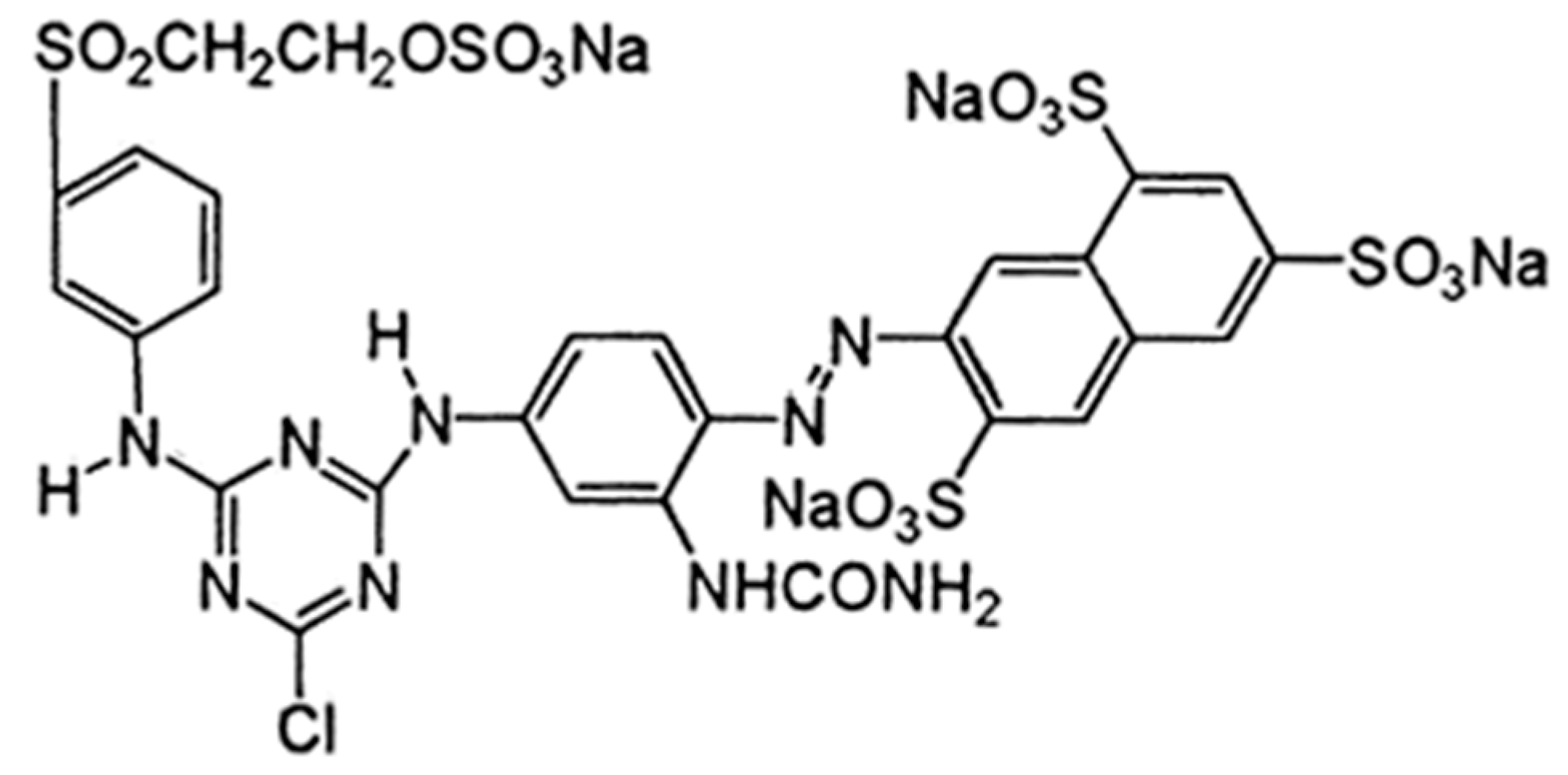Adsorptive Removal of Reactive Yellow 145 Dye from Textile Industry Effluent Using Teff Straw Activated Carbon: Optimization Using Central Composite Design
Abstract
1. Introduction
2. Materials and Methods
2.1. Preparation of Activated Carbon
2.2. Preparation of Reactive Yellow 145 Dye-Simulated Industrial Wastewater
2.3. Textile Effluent Collection and Chracterization
2.4. Design of Experiments towards Optimizing the Condition for TSAC Preparation
2.4.1. Regression Model
2.4.2. Statistical Optimization and Interaction Effect
2.4.3. Model Validation
2.5. Characterization of the Optimal TSAC
2.6. Yield of Activated Carbon Prepared under the Optimized Condition
2.7. Evaluation of the Process Variables for RY 145 Adsorption
2.8. Adsorptive Removal of COD from Real Textile Industry Effluent Using the Optimized TSAC
3. Results and Discussions
3.1. Central Composite Design
3.1.1. Fitting Model Equation and Statistical Analysis
3.1.2. Evaluation of Results from Design of Experiments
3.1.3. Adequacy of the Obtained RSM Model
3.1.4. The Effect of Operating Parameters on the Removal of RY 145 Dye
3.2. Effect of Operating Parameters on the Removal Efficiency of RY 145 Dye
3.2.1. Interaction Effect between Activation Temperature and Heating Time
3.2.2. Interaction Effect between H3PO4 and Activation Temperature
3.2.3. Interaction Effect between H3PO4 and Heating Time
3.2.4. Optimization and Model Validation
3.3. Characterization of the Optimized TSAC
3.4. Effect of Individual Process Design Parameters on the RY 145 Dye Removal Efficiency Using the Optimal TSAC
3.4.1. Effect of Contact Time
3.4.2. Effect of Solution PH
3.4.3. Effect of TSAC Dose
3.4.4. Effect of Initial RY 145 Dye Concentration
3.5. Removal of COD from Real Textile Effluent Using the Optimal TSAC
4. Conclusions
Author Contributions
Funding
Institutional Review Board Statement
Informed Consent Statement
Data Availability Statement
Acknowledgments
Conflicts of Interest
References
- El Kassimi, A.; El Himri, M.; Laamari, M.R.; El Haddad, M. Optimization of preparation conditions of highly efficient activated carbon for use in water treatment–experimental design approach. Int. J. Environ. Anal. Chem. 2023, 103, 491–513. [Google Scholar] [CrossRef]
- Natarajan, R.; Manivasagan, R. Effect of operating parameters on dye wastewater treatment using Prosopis cineraria and kinetic modeling. Environ. Eng. Res. 2020, 25, 788–793. [Google Scholar] [CrossRef]
- Ramos, M.D.; Lima., J.P.; de Aquino, S.F.; Aguiar, A. A critical analysis of the alternative treatments applied to effluents from Brazilian textile industries. J. Water Process. Eng. 2021, 43, 102273. [Google Scholar] [CrossRef]
- Parvin, F.; Islam, S.; Akm, S.I.; Urmy, Z.; Ahmed, S. A study on the solutions of environment pollutions and worker’s health problems caused by textile manufacturing operations. Biomed. J. Sci. Technol. Res. 2020, 28, 21831–21844. [Google Scholar]
- Tounsadi, H.; Metarfi, Y.; Taleb, M.; El Rhazi, K.; Rais, Z. Impact of chemical substances used in textile industry on the employee’s health: Epidemiological study. Ecotoxicol. Environ. Saf. 2020, 197, 110594. [Google Scholar] [CrossRef] [PubMed]
- Azanaw, A.; Birlie, B.; Teshome, B.; Jemberie, M. Textile effluent treatment methods and eco-friendly resolution of textile wastewater. Case Stud. Therm. Eng. 2022, 6, 100230. [Google Scholar] [CrossRef]
- Liyew, A.; Tizazu, Z.B. Synthesis of chemically modified bio sorbent from teff straw for adsorptive removal of Cr (VI): Characterization and optimization. Adsorp. Sci. Technol. 2022, 2022, 25. [Google Scholar]
- Zhao, H.; Cao, P.; Lu, L.; Li, F.; Pang, C.H.; Wu, T. Co-regulation of dispersion, exposure and defect sites on CeO2 (111) surface for catalytic oxidation of Hg0. J. Hazard. Mater. 2022, 424, 126566. [Google Scholar] [CrossRef] [PubMed]
- Samsami, S.; Mohamadizaniani, M.; Sarrafzadeh, M.H.; Rene, E.R.; Firoozbahr, M. Recent advances in the treatment of dye-containing wastewater from textile industries: Overview and perspectives. Process Saf. Environ. Prot. 2020, 143, 138–163. [Google Scholar] [CrossRef]
- Ai, L.; Zhang, C.; Liao, F.; Wang, Y.; LI, M.; Meng, L.; Jiang, J. Removal of methylene blue from aqueous solution with magnetite loaded multi-wall carbon nanotube: Kinetic, isotherm and mechanism analysis. J. Hazard. Mater. 2011, 198, 282–290. [Google Scholar] [CrossRef]
- Rahmani, A.R.; Mousavi-Tashar, A.; Masoumi, Z.; Azarian, G. Integrated advanced oxidation process, Sono-Fenton treatment, for mineralization and volume reduction of activated sludge. Ecotoxicol. Environ. Saf. 2019, 168, 120–126. [Google Scholar] [CrossRef] [PubMed]
- Akpomie, K.G.; Conradie, J. Advances in application of cotton-based adsorbents for heavy metals trapping, surface modifications and future perspectives. Ecotoxicol. Environ. Saf. 2020, 201, 110825. [Google Scholar] [CrossRef]
- Khulbe, K.; Matsuura, T. Removal of heavy metals and pollutants by membrane adsorption techniques. Appl. Water Sci. 2018, 8, 19. [Google Scholar] [CrossRef]
- Alimohammadi, Z.; Younesi, H.; Bahramifar, N. Batch and column adsorption of reactive red 198 from textile industry effluent by microporous activated carbon developed from walnut shells. Waste Biomass Valorization 2016, 7, 1255–1270. [Google Scholar] [CrossRef]
- Ayele, A.L.; Tizazu, B.Z.; Wassie, A.B. Chemical modification of teff straw biomass for adsorptive removal of Cr (VI) from aqueous solution: Characterization, optimization, kinetics, and thermodynamic aspects. Adsorpt. Sci. Technol. 2022, 2022, 5820207. [Google Scholar] [CrossRef]
- Yimer, J.; Yadav, O.; Kebede, T.; Mohammed, J. Kinetics and equilibrium study of adsorption of phenol red on teff (Eragrostis teff) husk activated carbon. Int. J. Innov. Sci. Res. 2014, 11, 471–476. [Google Scholar]
- Adane, T.; Haile, D.; Dessie, A.; Abebe, Y.; Dagne, H. Response surface methodology as a statistical tool for optimization of removal of chromium (VI) from aqueous solution by Teff (Eragrostis teff) husk activated carbon. Appl. Water Sci. 2020, 10, 37. [Google Scholar] [CrossRef]
- Berihun, D. Removal of chromium from industrial wastewater by adsorption using coffee husk. J. Mater. Sci. Eng. 2017, 6, 331. [Google Scholar] [CrossRef]
- Meunier, N.; Laroulandie, J.; Blais, J.F.; Tyagi, R.D. Cocoa shells for heavy metal removal from acidic solutions. Bioresour. Technol. 2003, 90, 255–263. [Google Scholar] [CrossRef]
- Martinez, M.; Miralles, N.; Hidalgo, S.; Fiol, N.; Villaescusa, I.; Poch, J. Removal of lead (II) and cadmium (II) from aqueous solutions using grape stalk waste. J. Hazard. Mater. 2006, 133, 203–211. [Google Scholar] [CrossRef]
- Pehlivan, E.; Altun, T.; Cetin, S.; Bhanger, M.I. Lead sorption by waste biomass of hazelnut and almond shell. J. Hazard. Mater. 2009, 167, 1203–1208. [Google Scholar] [CrossRef] [PubMed]
- Özcan, A.S.; Tunali, S.; Akar, T.; Kiran, I.; Gedikbey, T. Adsorption potential of lead (II) ions from aqueous solutions onto Capsicum annuum seeds. Sep. Sci. Technol. 2007, 42, 137–151. [Google Scholar] [CrossRef]
- Asgher, M.; Bhatti, H.N. Mechanistic and kinetic evaluation of biosorption of reactive azo dyes by free, immobilized and chemically treated Citrus sinensis waste biomass. Ecol. Eng. 2010, 36, 1660–1665. [Google Scholar] [CrossRef]
- Alam, M.M.; Hossain, M.A.; Hossain, M.D.; Johir, M.; Hossen, J.; Rahman, M.S.; Zhou, J.L.; Hasan, A.K.; Karmakar, A.K.; Ahmed, M.B. The potentiality of rice husk-derived activated carbon: From synthesis to application. Processes 2020, 8, 203. [Google Scholar] [CrossRef]
- Wassie, A.; Srivastava, V.C. Chemical treatment of teff straw by sodium hydroxide, phosphoric acid and zinc chloride: Adsorptive removal of chromium. Int. J. Environ. Sci. Technol. 2016, 13, 2415–2426. [Google Scholar] [CrossRef]
- Tadesse, B.; Teju, E.; Megersa, N. The Teff straw: A novel low-cost adsorbent for quantitative removal of Cr (VI) from contaminated aqueous samples. Desalin. Water Treat. 2015, 56, 2925–2936. [Google Scholar]
- Beyan, S.M.; Ambio, T.A.; Sundramurthy, V.P.; Gomadurai, C.; Getahun, A.A. Adsorption phenomenon for removal of Pb (II) via teff straw based activated carbon prepared by microwave-assisted pyrolysis: Process modelling, statistical optimisation, isotherm, kinetics, and thermodynamic studies. Int. J. Environ. Anal. Chem. 2022. [Google Scholar] [CrossRef]
- Alahiane, S.; Sennaoui, A.; Sakr, F.; Dinne, M.; Qourzal, S.; Assabbane, A. Photo-mineralization of azo dye reactive yellow 145 in aqueous medium by TiO2-coated non-woven fibres. Mediterr. J. Chem. 2020, 10, 107–115. [Google Scholar] [CrossRef]
- Bokhari, T.H.; Kashif, M.; Bhatti, I.A.; Zubair, M.; Adeel, S.; Yousaf, M.; Ahmad, M.; Iqbal, M.; Usman, M.; Zuber, M. Degradation study of CI reactive yellow 145 by advanced oxidation process. Asian J. Chem. 2013, 25, 8668–8672. [Google Scholar] [CrossRef]
- Muneer, M.; Kanjal, M.I.; Saeed, M.; Javed, T.; Haq, A.U.; Den, N.Z.U.; Jamal, M.A.; Ali, S.; Iqbal, M. High energy radiation induced degradation of reactive yellow 145 dye: A mechanistic study. Radiat. Phys. Chem. 2020, 177, 109115. [Google Scholar] [CrossRef]
- Asaithambi, P.; Beyene, D.; Aziz, A.R.A.; Alemayehu, E. Removal of pollutants with determination of power consumption from landfill leachate wastewater using an electrocoagulation process: Optimization using response surface methodology (RSM). Appl. Water Sci. 2018, 8, 69. [Google Scholar] [CrossRef]
- Hameed, B.; Tan, I.; Ahmad, A. Preparation of oil palm empty fruit bunch-based activated carbon for removal of 2, 4, 6-trichlorophenol: Optimization using response surface methodology. J. Hazard. Mater. 2009, 164, 1316–1324. [Google Scholar] [CrossRef] [PubMed]
- Sureshkumar, A.; Susmita, M. Optimization of preparation conditions for activated carbons from polyethylene terephthalate using response surface methodology. Braz. J. Chem. Eng. 2018, 35, 1105–1116. [Google Scholar] [CrossRef]
- Danish, M.; Ahmad, T.; Nadhari, W.; Ahmad, M.; Khanday, W.A.; Ziyang, L.; Pin, Z. Optimization of banana trunk-activated carbon production for methylene blue-contaminated water treatment. Appl. Water Sci. 2018, 8, 9. [Google Scholar] [CrossRef]
- Ahmad, A.; Hameed, B. Effect of preparation conditions of activated carbon from bamboo waste for real textile wastewater. J. Hazard. Mater. 2010, 173, 487–493. [Google Scholar] [CrossRef] [PubMed]
- Salman, J.M. Optimization of preparation conditions for activated carbon from palm oil fronds using response surface methodology on removal of pesticides from aqueous solution. Arab. J. Chem. 2014, 7, 101–108. [Google Scholar] [CrossRef]
- Kalavathy, H.; Regupathi, I.; Pillai, M.G.; Miranda, L.R. Modelling, analysis and optimization of adsorption parameters for H3PO4 activated rubber wood sawdust using response surface methodology (RSM). Colloids Surf. B Biointerfaces 2009, 70, 35–45. [Google Scholar] [CrossRef] [PubMed]
- Sudaryanto, Y.; Hartono, S.Á.; Irawaty, W.; Hindarso, H.; Ismadji, S. High surface area activated carbon prepared from cassava peel by chemical activation. Bioresour. Technol. 2006, 97, 734–739. [Google Scholar] [CrossRef]
- Chiou, N.R.; Lu, C.; Guan, J.; Lee, L.J.; Epstein, A.J. Growth and alignment of polyaniline nanofibres with superhydrophobic, superhydrophilic and other properties. Nat. Nanotechnol. 2007, 2, 354–357. [Google Scholar] [CrossRef]
- Omri, A.; Benzina, M. Characterization of activated carbon prepared from a new raw lignocellulosic material: Ziziphus spina-christi seeds. J. Société Chim. Tunis. 2012, 14, 175–183. [Google Scholar]
- Shamsuddin, M.; Yusoff, N.; Sulaiman, M. Synthesis and characterization of activated carbon produced from kenaf core fiber using H3PO4 activation. Procedia Chem. 2016, 19, 558–565. [Google Scholar] [CrossRef]
- Yihunu, E.W.; Yu, H.; Junhe, W.; Kai, Z.; Teffera, Z.L.; Weldegebrial, B.; Limin, M. A comparative study on defluoridation capabilities of biosorbents: Isotherm, kinetics, thermodynamics, cost estimation and regeneration study. Environ. Eng. Res. 2020, 25, 384–392. [Google Scholar] [CrossRef]
- Bello, O.S.; Adegoke, K.A.; Akinyunni, O.O. Preparation and characterization of a novel adsorbent from Moringa oleifera leaf. Appl. Water Sci. 2017, 7, 1295–1305. [Google Scholar] [CrossRef]
- Ghaedi, M.; Nasab, A.G.; Khodadoust, S.; Rajabi, M.; Azizian, S. Application of activated carbon as adsorbents for efficient removal of methylene blue: Kinetics and equilibrium study. J. Ind. Eng. Chem. 2014, 20, 2317–2324. [Google Scholar] [CrossRef]
- Mall, I.D.; Srivastava, V.C.; Agarwal, N.K.; Mishra, I.M. Adsorptive removal of malachite green dye from aqueous solution by bagasse fly ash and activated carbon-kinetic study and equilibrium isotherm analyses. Colloids Surf. A Physicochem. Eng. Asp. 2005, 264, 17–28. [Google Scholar] [CrossRef]
- Krishnasamy, S.; Saiatchyuth, B.A.; Ravindiran, G.; Subramaniyan, B.; Ramalingam, M.; Sai Vamsi, J.U.B.; Ramesh, B.; Razack, N.A. Effective removal of reactive yellow 145 (RY145) using biochar derived from groundnut shell. Adv. Mater. Sci. Eng. 2022, 2022, 8715669. [Google Scholar] [CrossRef]
- Elabbas, S.; Mandi, L.; Berrekhis, F.; Pons, M.N.; Leclerc, J.P.; Ouazzani, N. Removal of Cr (III) from chrome tanning wastewater by adsorption using two natural carbonaceous materials: Eggshell and powdered marble. J. Environ. Manag. 2016, 166, 589–595. [Google Scholar] [CrossRef]
- Li, D.; Yan, J.; Liu, Z.; Liu, Z. Adsorption kinetic studies for removal of methylene blue using activated carbon prepared from sugar beet pulp. Int. J. Environ. Sci. Technol. 2016, 13, 1815–1822. [Google Scholar] [CrossRef]
- Hamed, M.M.; Ahmed, I.; Metwally, S. Adsorptive removal of methylene blue as organic pollutant by marble dust as eco-friendly sorbent. J. Ind. Eng. Chem. 2014, 20, 2370–2377. [Google Scholar] [CrossRef]
- Kazi, S.A.; Iqbal, H.H.; Shahid, N.; Shah, G.M.; Jameel, N. Removal of reactive dye yellow 145 by adsorption using white quartz. Bull. Environ. Stud. 2016, 1, 43. [Google Scholar]
- Abate, G.Y.; Alene, A.N.; Habte, A.T.; Getahun, D.M. Adsorptive removal of malachite green dye from aqueous solution onto activated carbon of Catha edulis stem as a low cost bio-adsorbent. Environ. Syst. Res. 2020, 9, 29. [Google Scholar] [CrossRef]
- Mondal, N.K.; Kar, S. Potentiality of banana peel for removal of Congo red dye from aqueous solution: Isotherm, kinetics and thermodynamics studies. Appl. Water Sci. 2018, 8, 157. [Google Scholar] [CrossRef]
- Rahmat, N.A.; Ali, A.A.; Hussain, N.; Muhamad, M.S.; Kristanti, R.A.; Hadibarata, T. Removal of Remazol Brilliant Blue R from aqueous solution by adsorption using pineapple leaf powder and lime peel powder. Water Air Soil Pollut. 2016, 227, 105. [Google Scholar] [CrossRef]
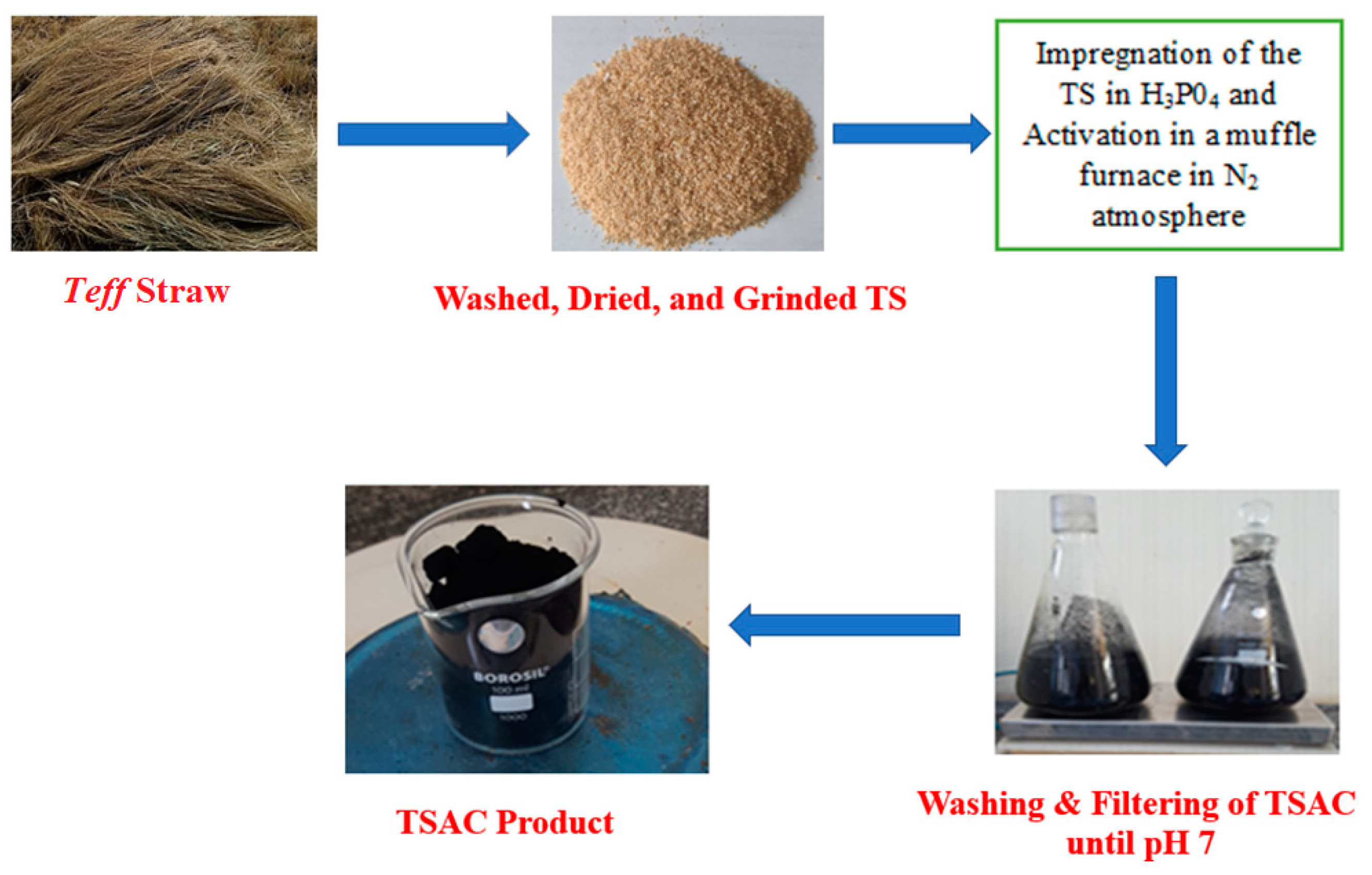


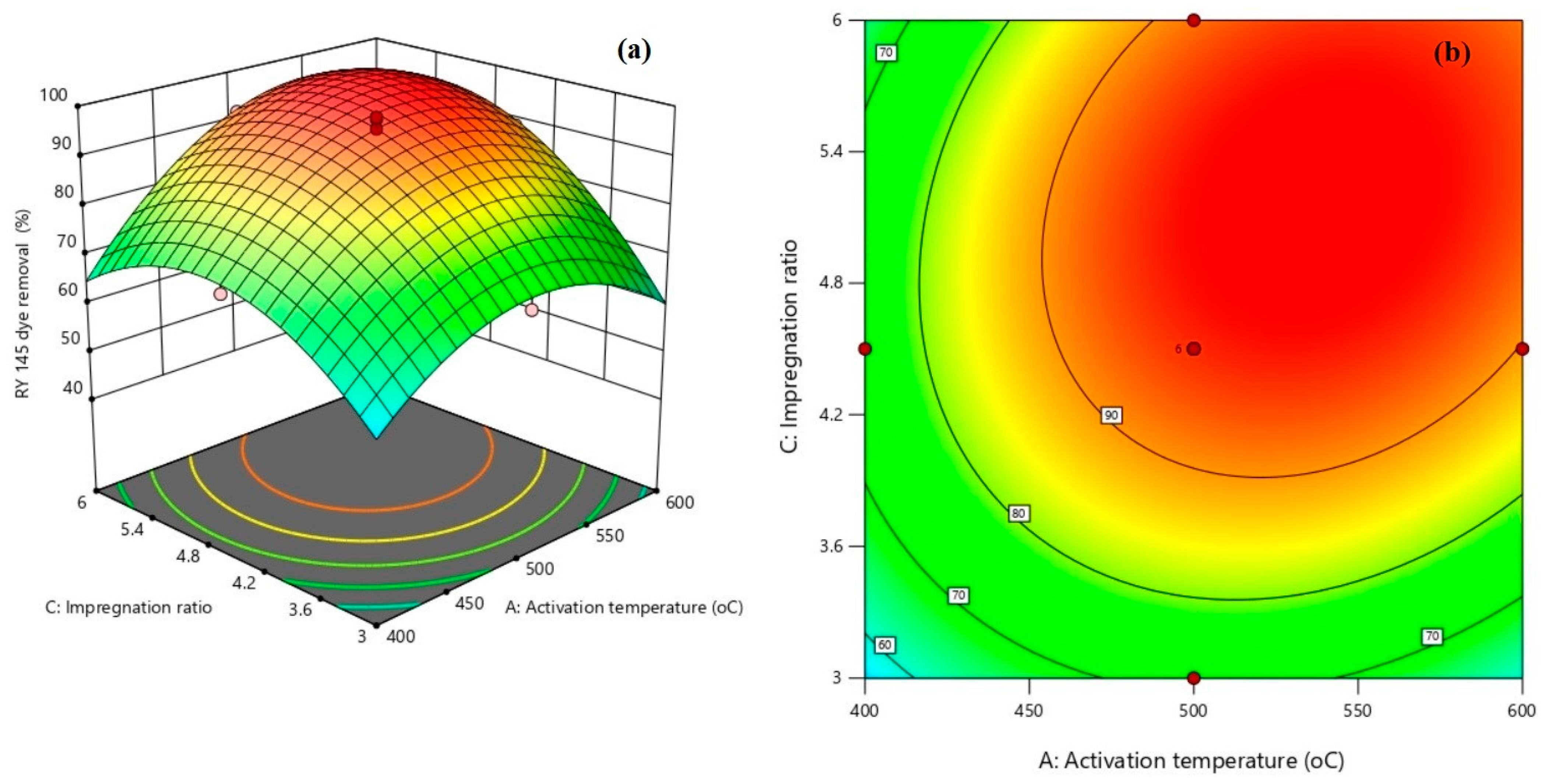
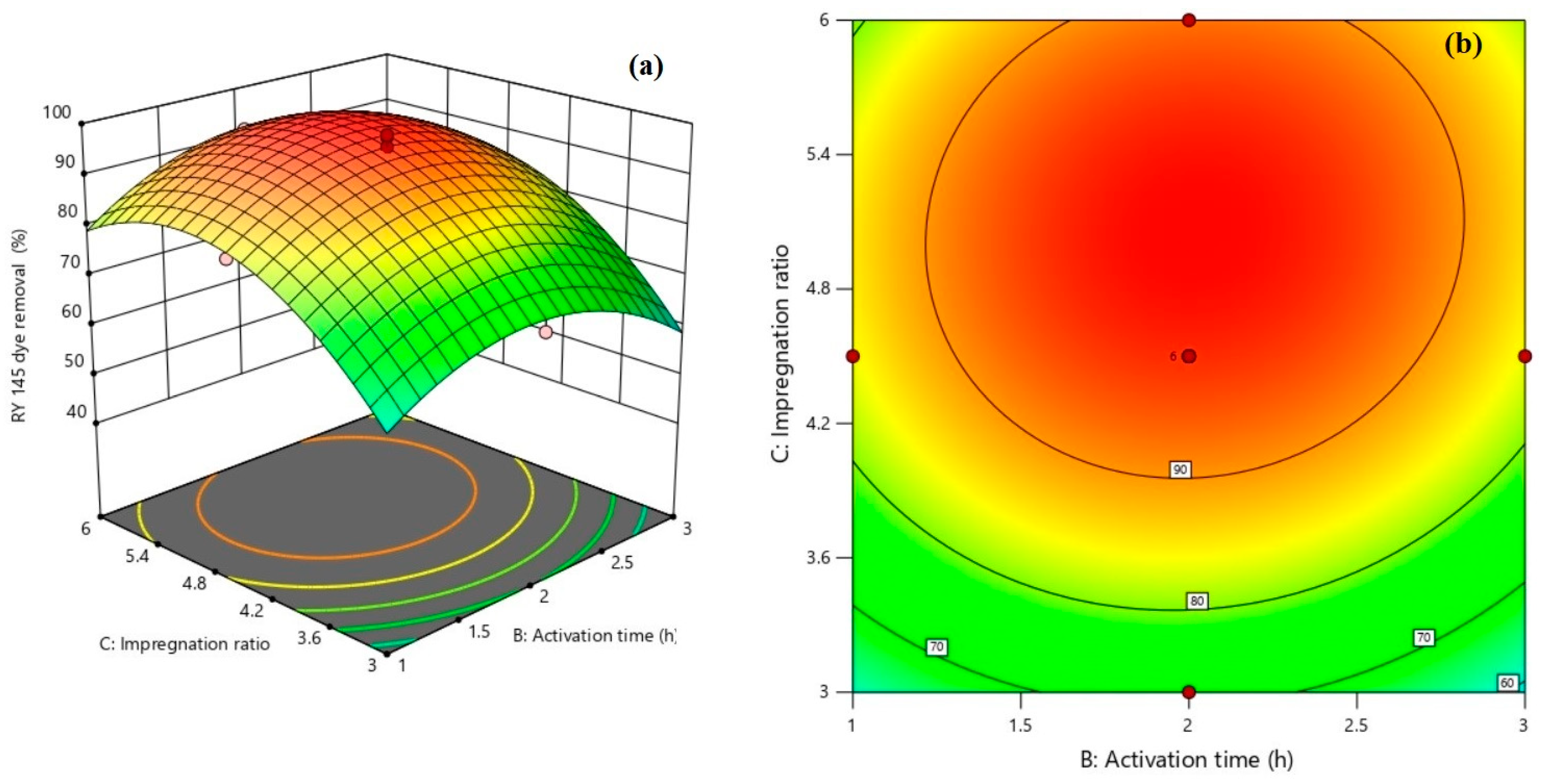
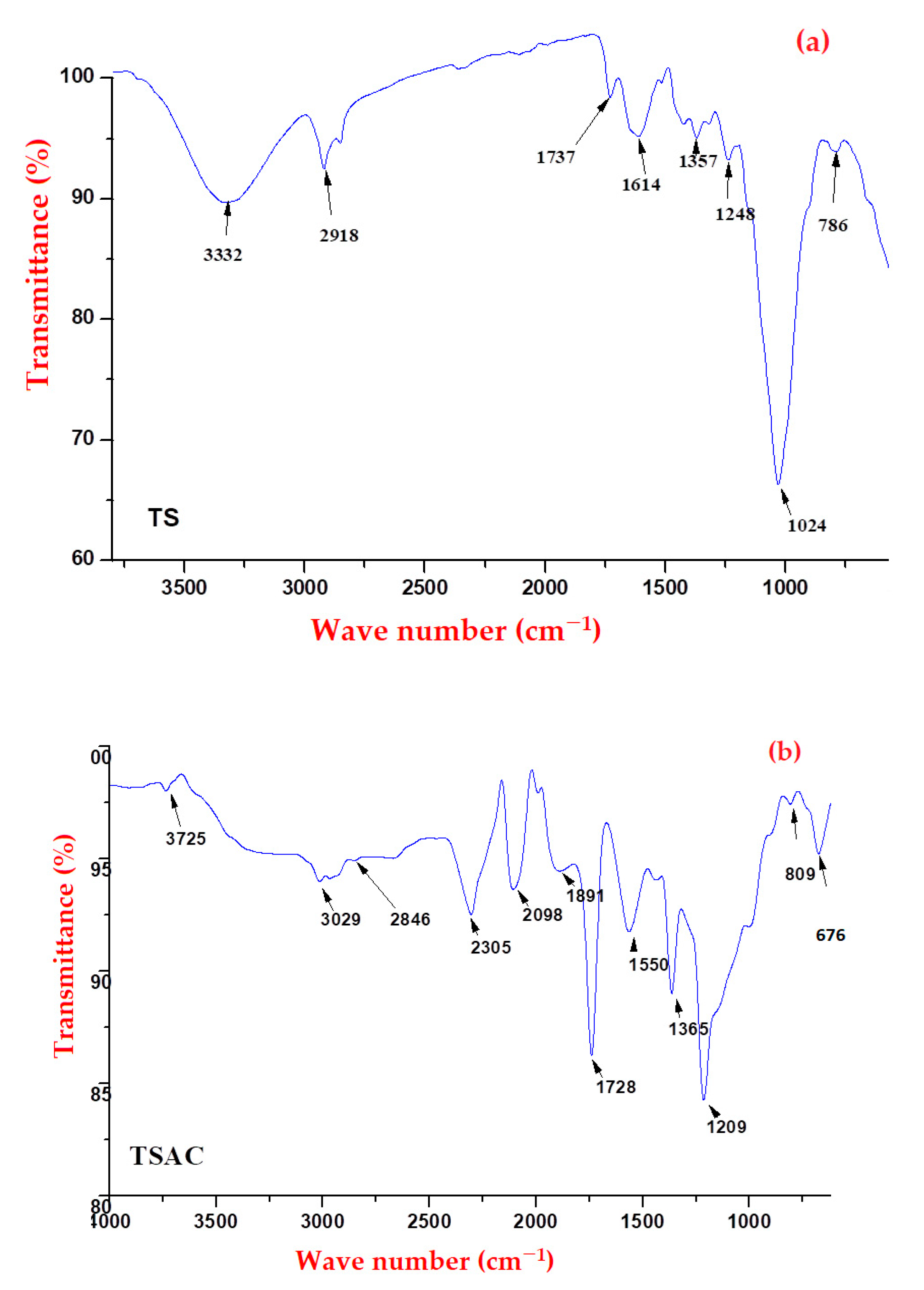
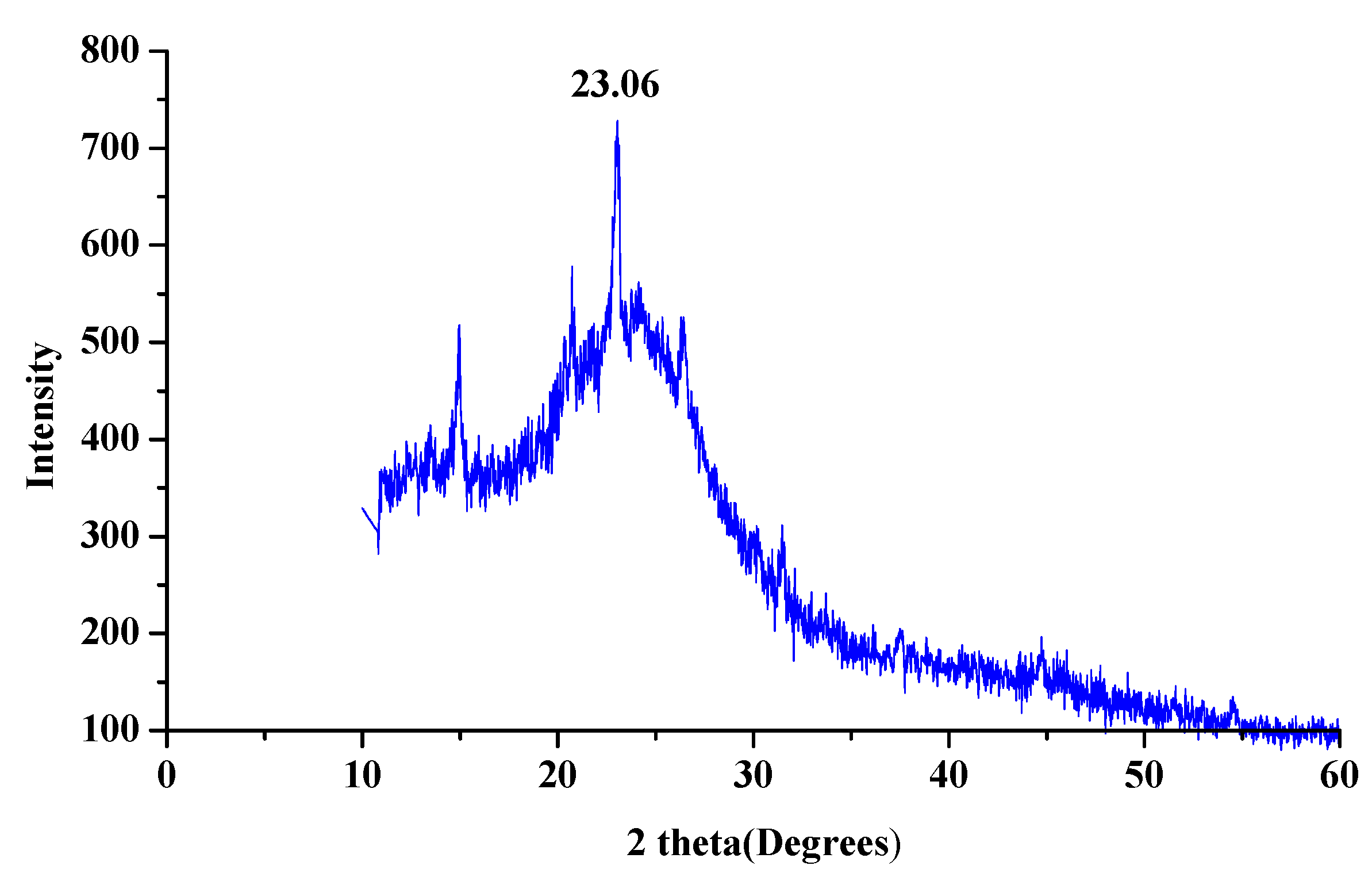

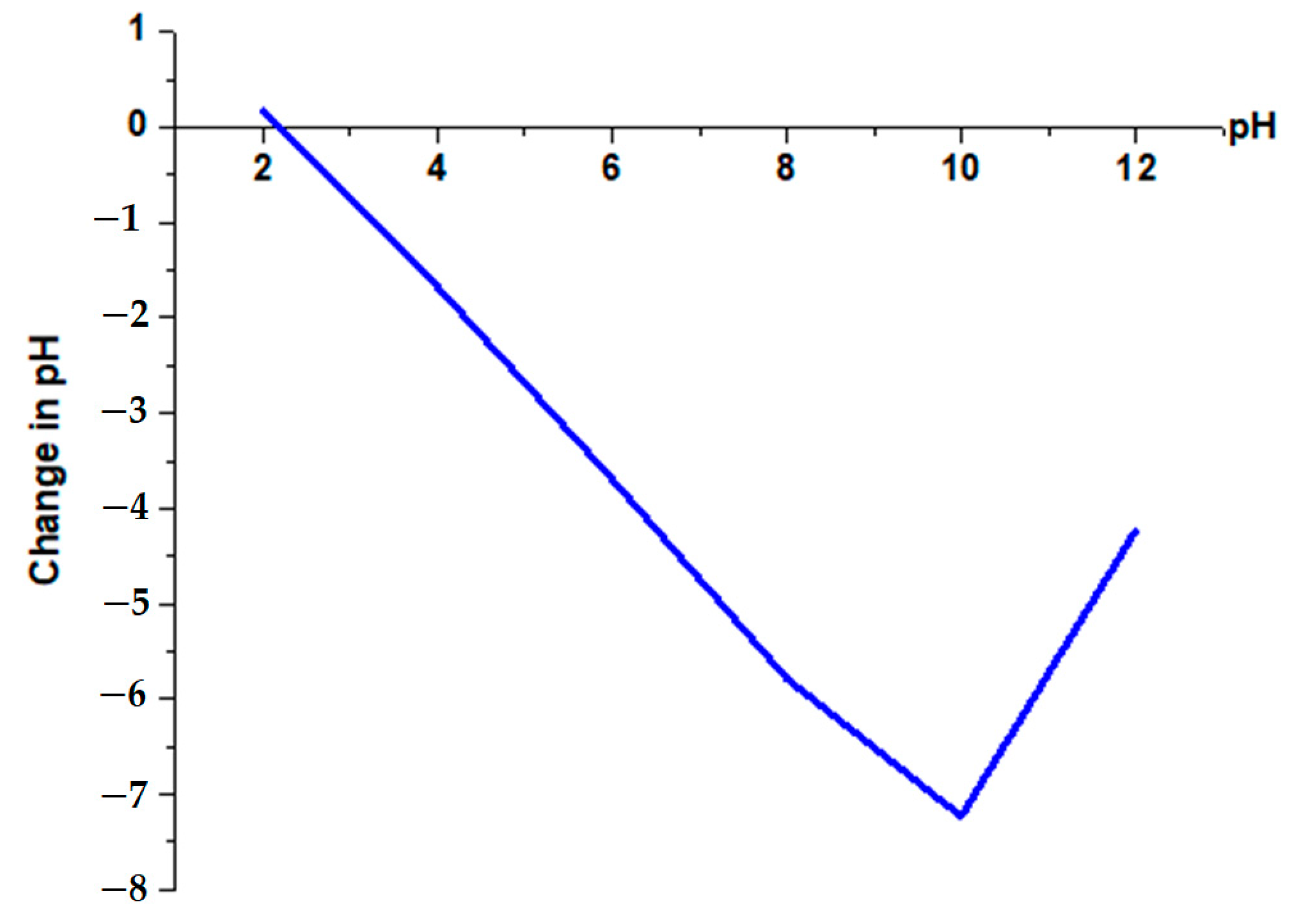
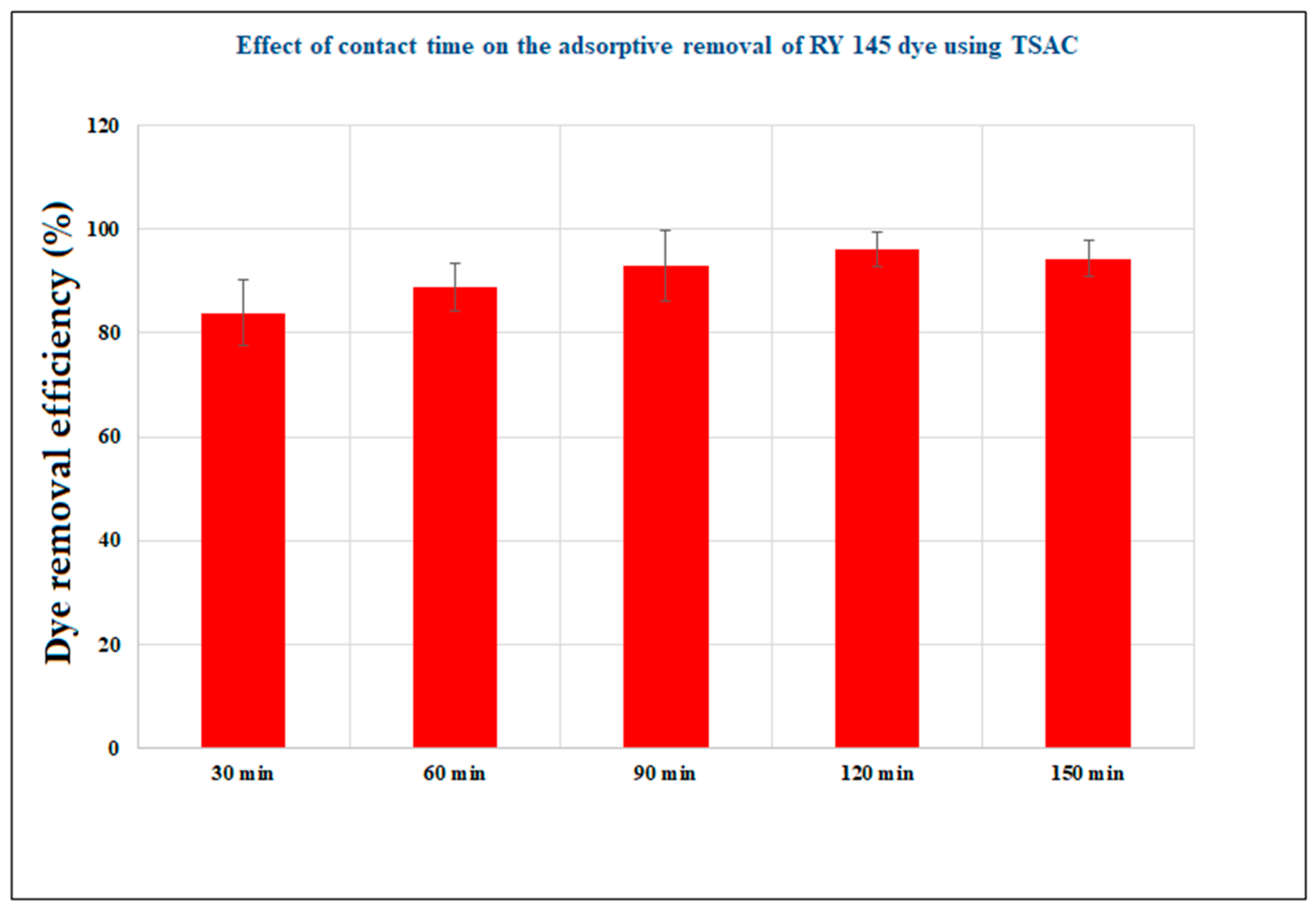

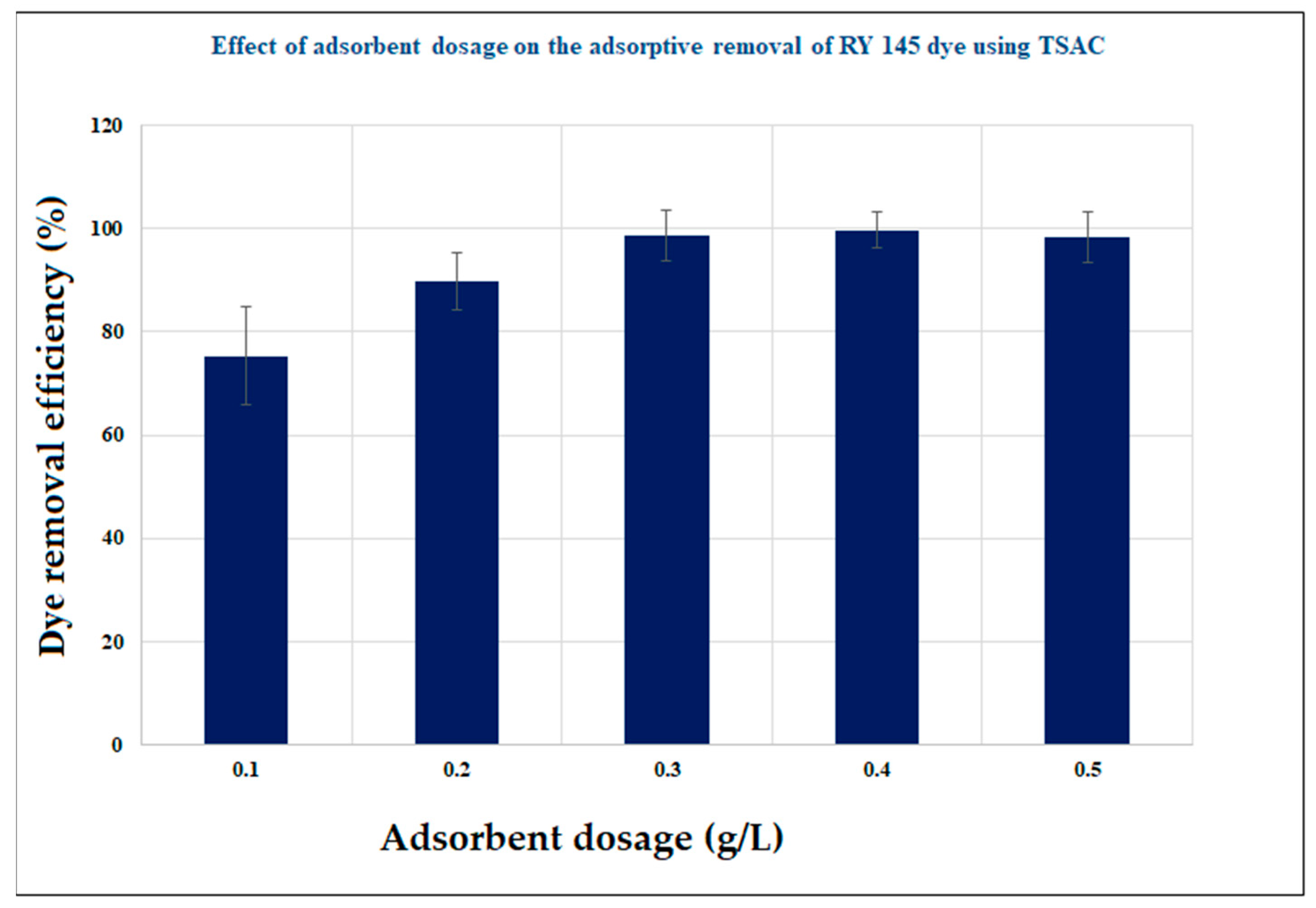
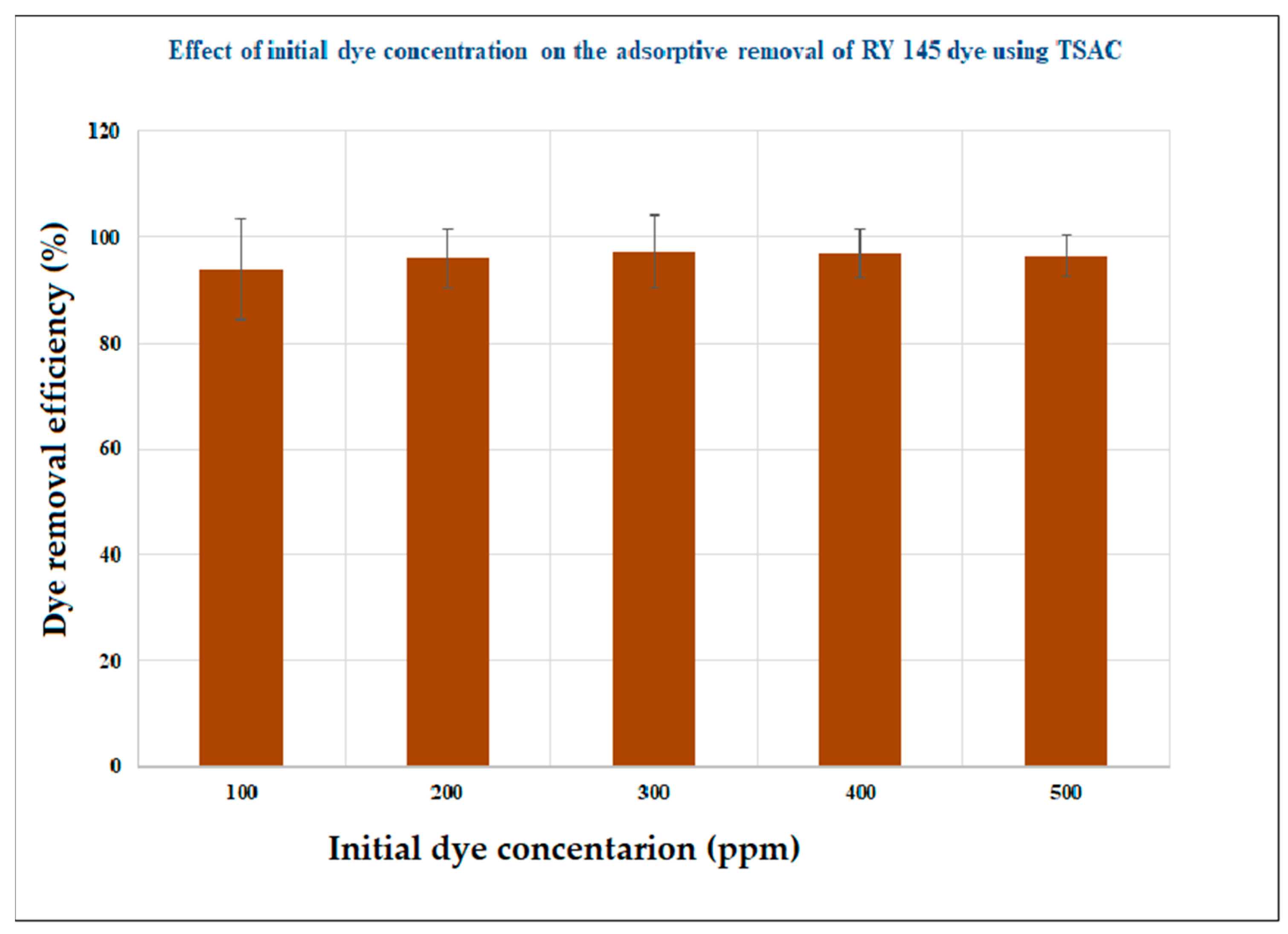

| Characteristics | RY 145 Dye |
|---|---|
| C.I. generic name | C.I. RY 145 dye |
| Molecular formula | C28H20ClN9Na4O16S5 |
| Molecular weight | 1026.25 |
| λmax | 418 nm |
| Temp (°C) | PH | COD (mg/L) | EC (µS/cm) | TDS (mg/L) |
|---|---|---|---|---|
| 10.28 | 9.8 | 804 | 7673 | 3321 |
| Independent Variables | Range and Levels | ||
|---|---|---|---|
| −1 | 0 | 1 | |
| Heating time (h) | 1 | 2 | 3 |
| Temperature (°C) | 400 | 500 | 600 |
| Impregnation ratio | 3 | 4.5 | 6 |
| Run | Activated Carbon Preparation Variables | Response | |||
|---|---|---|---|---|---|
| Activation Temperature, (°C) | Activation Time (h) | Amount of H3PO4 (g) | RY 145 Dye Removal Efficiency (%) | ||
| Experimental | Predicted | ||||
| 1 | 400 | 1 | 3 | 46.14 | 46.9322 |
| 2 | 600 | 1 | 3 | 50.75 | 48.9327 |
| 3 | 400 | 3 | 3 | 44.05 | 41.9205 |
| 4 | 600 | 3 | 3 | 47.5 | 48.2717 |
| 5 | 400 | 1 | 6 | 54.6 | 53.0979 |
| 6 | 600 | 1 | 6 | 76.56 | 77.9591 |
| 7 | 400 | 3 | 6 | 52.34 | 53.4254 |
| 8 | 600 | 3 | 6 | 84.16 | 82.6374 |
| 9 | 400 | 2 | 4.5 | 72.32 | 74.0738 |
| 10 | 600 | 2 | 4.5 | 88.51 | 89.6800 |
| 11 | 500 | 1 | 4.5 | 82.95 | 84.0800 |
| 12 | 500 | 3 | 4.5 | 82.12 | 83.9133 |
| 13 | 500 | 2 | 3 | 69.23 | 71.6128 |
| 14 | 500 | 2 | 6 | 91.34 | 91.8785 |
| 15 | 500 | 2 | 4.5 | 97.84 | 95.4860 |
| 16 | 500 | 2 | 4.5 | 94.98 | 95.4860 |
| 17 | 500 | 2 | 4.5 | 95.24 | 95.4860 |
| 18 | 500 | 2 | 4.5 | 97.41 | 95.4860 |
| 19 | 500 | 2 | 4.5 | 95.51 | 95.4860 |
| 20 | 500 | 2 | 4.5 | 97.78 | 95.4860 |
| Source | Std. Dev. | R² | Adjusted R² | Predicted R² | PRESS | |
|---|---|---|---|---|---|---|
| Linear | 19.15 | 0.2180 | 0.0713 | −0.4100 | 10,581.55 | |
| 2FI | 20.72 | 0.2559 | −0.0875 | −4.5445 | 41,608.84 | |
| Quadratic | 2.16 | 0.9938 | 0.9882 | 0.9376 | 468.64 | Suggested |
| Cubic | 2.19 | 0.9962 | 0.9879 | −2.2063 | 24,062.15 | Aliased |
| Coefficient of variance = 2.83 | Adequate precision = 55.767 | |||||
| Source | Sum of Squares | df | Mean Square | F-Value | p-Value | |
|---|---|---|---|---|---|---|
| Model | 7458.05 | 9 | 828.67 | 178.22 | <0.0001 | significant |
| A—Activation temperature | 608.87 | 1 | 608.87 | 130.94 | <0.0001 | |
| B—Activation time | 0.0689 | 1 | 0.0689 | 0.0148 | 0.9055 | |
| C—Amount of H3PO4 | 1026.78 | 1 | 1026.78 | 220.82 | <0.0001 | |
| AB | 9.46 | 1 | 9.46 | 2.03 | 0.1842 | |
| AC | 261.29 | 1 | 261.29 | 56.19 | <0.0001 | |
| BC | 14.26 | 1 | 14.26 | 3.07 | 0.1105 | |
| A2 | 509.35 | 1 | 509.35 | 109.54 | <0.0001 | |
| B2 | 363.03 | 1 | 363.03 | 78.07 | <0.0001 | |
| C2 | 519.13 | 1 | 519.13 | 111.65 | <0.0001 | |
| Residual | 46.50 | 10 | 4.65 | |||
| Lack of Fit | 37.37 | 5 | 7.47 | 4.09 | 0.0741 | not significant |
| Pure Error | 9.13 | 5 | 1.83 | |||
| Cor Total | 7504.55 | 19 |
| Optimum Condition | RY 145 Dye Removal | ||||
|---|---|---|---|---|---|
| Activation Temperature (°C) | Activation Time (h) | Impregnation Ratio | Predicted Value (%) | Experimental Value (%) | Error (%) |
| 539 | 2 | 1:5 | 99.2571 | 98.53 | 0.73 |
Disclaimer/Publisher’s Note: The statements, opinions and data contained in all publications are solely those of the individual author(s) and contributor(s) and not of MDPI and/or the editor(s). MDPI and/or the editor(s) disclaim responsibility for any injury to people or property resulting from any ideas, methods, instructions or products referred to in the content. |
© 2023 by the authors. Licensee MDPI, Basel, Switzerland. This article is an open access article distributed under the terms and conditions of the Creative Commons Attribution (CC BY) license (https://creativecommons.org/licenses/by/4.0/).
Share and Cite
Kifetew, M.; Alemayehu, E.; Fito, J.; Worku, Z.; Prabhu, S.V.; Lennartz, B. Adsorptive Removal of Reactive Yellow 145 Dye from Textile Industry Effluent Using Teff Straw Activated Carbon: Optimization Using Central Composite Design. Water 2023, 15, 1281. https://doi.org/10.3390/w15071281
Kifetew M, Alemayehu E, Fito J, Worku Z, Prabhu SV, Lennartz B. Adsorptive Removal of Reactive Yellow 145 Dye from Textile Industry Effluent Using Teff Straw Activated Carbon: Optimization Using Central Composite Design. Water. 2023; 15(7):1281. https://doi.org/10.3390/w15071281
Chicago/Turabian StyleKifetew, Melkamu, Esayas Alemayehu, Jemal Fito, Zemene Worku, Sundramurthy Venkatesa Prabhu, and Bernd Lennartz. 2023. "Adsorptive Removal of Reactive Yellow 145 Dye from Textile Industry Effluent Using Teff Straw Activated Carbon: Optimization Using Central Composite Design" Water 15, no. 7: 1281. https://doi.org/10.3390/w15071281
APA StyleKifetew, M., Alemayehu, E., Fito, J., Worku, Z., Prabhu, S. V., & Lennartz, B. (2023). Adsorptive Removal of Reactive Yellow 145 Dye from Textile Industry Effluent Using Teff Straw Activated Carbon: Optimization Using Central Composite Design. Water, 15(7), 1281. https://doi.org/10.3390/w15071281







